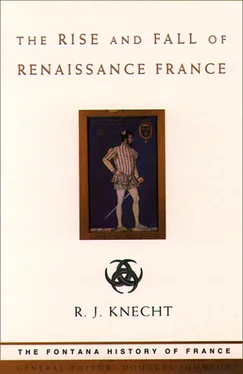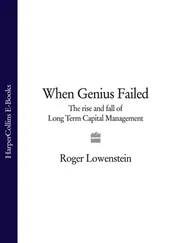Although France did not as yet think of pushing her eastern frontier to the Rhine, Charles did not ignore the eastern and northern borders of his kingdom. Like his father and sister, he sought allies in Flanders, first the large communes, then the nobles running the government. In 1494, Philip the Fair, governor of the Low Countries, paid homage to the king for Flanders, thereby effectively guaranteeing much of France’s northern frontier. In 1492, Charles VIII was offered the suzerainty of Liège, but he wisely refused. Had he accepted, he would have had to intervene countless times in Flemish and German affairs.
A comparison of the three treaties of 1492 and 1493 suggests that the best for France was the Treaty of Etaples, for it disposed of England’s traditional enmity without loss of territory. France’s acquisition of Brittany made up for the loss of Franche-Comté and Artois in the Treaty of Senlis. She also scored a diplomatic triumph by obtaining implicit recognition of Charles VIII’s marriage. Only the Treaty of Barcelona was seriously damaging. The return of Roussillon and Cerdagne to Spain, though legally justified, failed to ensure stable Franco-Spanish relations: the two powers were soon to fall out in Italy. Yet, in exchange for her sacrifices, France, including Brittany, gained domestic peace for the remainder of Charles VIII’s reign.
THREE Charles VIII and the Italian Wars(1494–8)
In 1494, King Charles VIII invaded Italy and conquered the kingdom of Naples. His action marked the beginning of a series of French campaigns south of the Alps which have come to be known as the Italian Wars. They lasted on and off till the Peace of Cateau-Cambrésis of 1559.
Italy at the end of the fifteenth century was a tempting prey to a more powerful neighbour, for it was divided into a large number of more or less independent states which could be played off against each other. The most important were Venice, Milan, Florence, the States of the Church and Naples. The Venetian republic, though threatened by the westward expansion of the Ottoman empire, was at the height of its power. In addition to an extensive territory on the mainland, it controlled lands along the Adriatic seaboard, in the Aegean and in the eastern Mediterranean. The Venetian constitution was the most stable in Italy, being vested in an aristocratic oligarchy and exercised through a well-balanced system of councils. To the west lay the duchy of Milan which the house of Visconti had created out of a collection of cities; it was now ruled by the house of Sforza under which it continued to prosper economically. A strong Milan was regarded by other Italian states as a necessary bulwark against foreign invasion and Venetian expansionism. Florence was ruled in theory by a popular government, but effective authority was in the hands of the Medici family. Though weak militarily, the republic was influential among the other Italian states on account of the Medicis’ extensive banking connections and genius for diplomacy. The States of the Church stretched diagonally across the Italian peninsula from the Tiber to the Po and comprised a number of virtually autonomous towns and districts. The city of Rome was continually disturbed by the feuds of its leading families, while dreams of republican government still stirred among its inhabitants. A principal aim of the Renaissance popes was to establish their authority firmly throughout their territories, a policy which often led them into nepotism. Naples, the only feudal monarchy in the peninsula, was a land of large estates ruled by turbulent barons. It was divided into two parts: Sicily belonged to the house of Aragon, while Naples and the mainland were ruled by an illegitimate branch of the same house. Notable among the lesser Italian states were the duchy of Savoy, sitting astride the Alps and under the shadow of France; the republic of Genoa, which had lapsed into political insignificance as a result of domestic squabbles; and the duchy of Ferrara, serving as a buffer state between Venice and the States of the Church.
Following the Peace of Lodi (1454) the preservation of order in Italy was made to depend on a close understanding between Milan, Florence and Naples, which Lorenzo de’ Medici strove untiringly to maintain. His son Piero, however, who succeeded him in 1492, lacked political judgement. By leaning too heavily on the side of Naples he upset the tripartite axis and precipitated a breakdown of relations between Milan and Naples. Isabella of Aragon, duchess of Milan, was the daughter of Alfonso duke of Calabria and granddaughter of Ferrante I, king of Naples. She and her husband, Giangaleazzo Sforza, felt overshadowed by the regent, Lodovico Sforza. Alfonso was always looking for an opportunity to extend his power in Italy. He also remembered that his grandfather, Alfonso I of Naples, had been named by Filippo Maria Visconti duke of Milan (d. 1447) as his heir. As the duke prepared to attack Milan, Lodovico turned to France for help. He probably did not wish to bring the king of France into the peninsula, only to shelter beneath the threat of a French invasion. But there were others, apart from Lodovico, who were urging the king of France to make good his own claim to the kingdom of Naples.
French intervention in the area had a long history. The emperor Charlemagne had carried the defence of Christendom to the heart of Italy. The Capetian kings, on the other hand, had been content to observe Italian affairs from afar. St Louis refused the kingdom of Sicily, but allowed his brother Charles comte d’Anjou to respond to calls for help from the papacy and to accept for himself and his heirs territories in southern Italy. In 1481, Louis XI inherited the Angevin lands, including the county of Provence and the kingdom of Naples, but was too near death to take possession of them. In 1486 the annexation of Provence to the kingdom of France was formally ratified by the Parlement of Paris; but the claim to Naples was disputed between the king of France and the duke of Lorraine.
An additional complication was the fact that Naples was a papal fief. Its hereditary transmission was determined by a bull of investiture of 1265 which conferred the kingdom on Charles d’Anjou and his heirs in the direct or collateral line up to the fourth degree of kinship. Charles VIII was too far removed in kinship from Charles d’Anjou to qualify, but this did not deter him from pressing his claim. In 1493, Naples was ruled by Ferrante I, the brother-in-law of Ferdinand of Aragon, as part of a kingdom comprising the whole of Italy south of the States of the Church except Sicily which belonged to Ferdinand. Ferrante was hardly a docile vassal of the papacy: he had been excommunicated by Pope Innocent VIII and had opposed the election of Alexander VI, who repeatedly called on the French king to attack Naples.
Charles VIII wanted Naples not only for itself but as a springboard from which to launch a crusade against the Turks. The fifteenth century had seen a rapid expansion of Turkish power westward under Sultan Mehmet II. After capturing Greece and Albania, the Turks established a foothold in southern Italy in August 1480. The death of Mehmet in May 1481 was followed by a respite. In 1482 the Turks were driven out of southern Italy, but they remained a threat. There was general agreement among the Christian powers of the need for a new crusade aimed ultimately at freeing Constantinople and the Holy Places; but there was no consensus as to who should lead it. Two possible candidates were Charles VIII and Maximilian, King of the Romans. Although Philippe de Commynes doubted Charles’s sincerity in proposing a crusade, ample evidence suggests otherwise. As Robert Gaguin, on an embassy to England, explained: the king, his master, was anxious to follow the example set by Henry IV of England, who at the end of his life had planned to lead an expedition to the Holy Land. He was also much impressed by the efforts of Ferdinand of Aragon to wrest the kingdom of Granada from the Saracens. A Venetian envoy wrote from Rome in June 1495: ‘You may be sure that the king’s intention is to attack the Turks. He has made the vow to God and would already have launched his enterprise if so many troubles had not befallen him. I, who have spoken to His Majesty, know this to be true.’
Читать дальше












